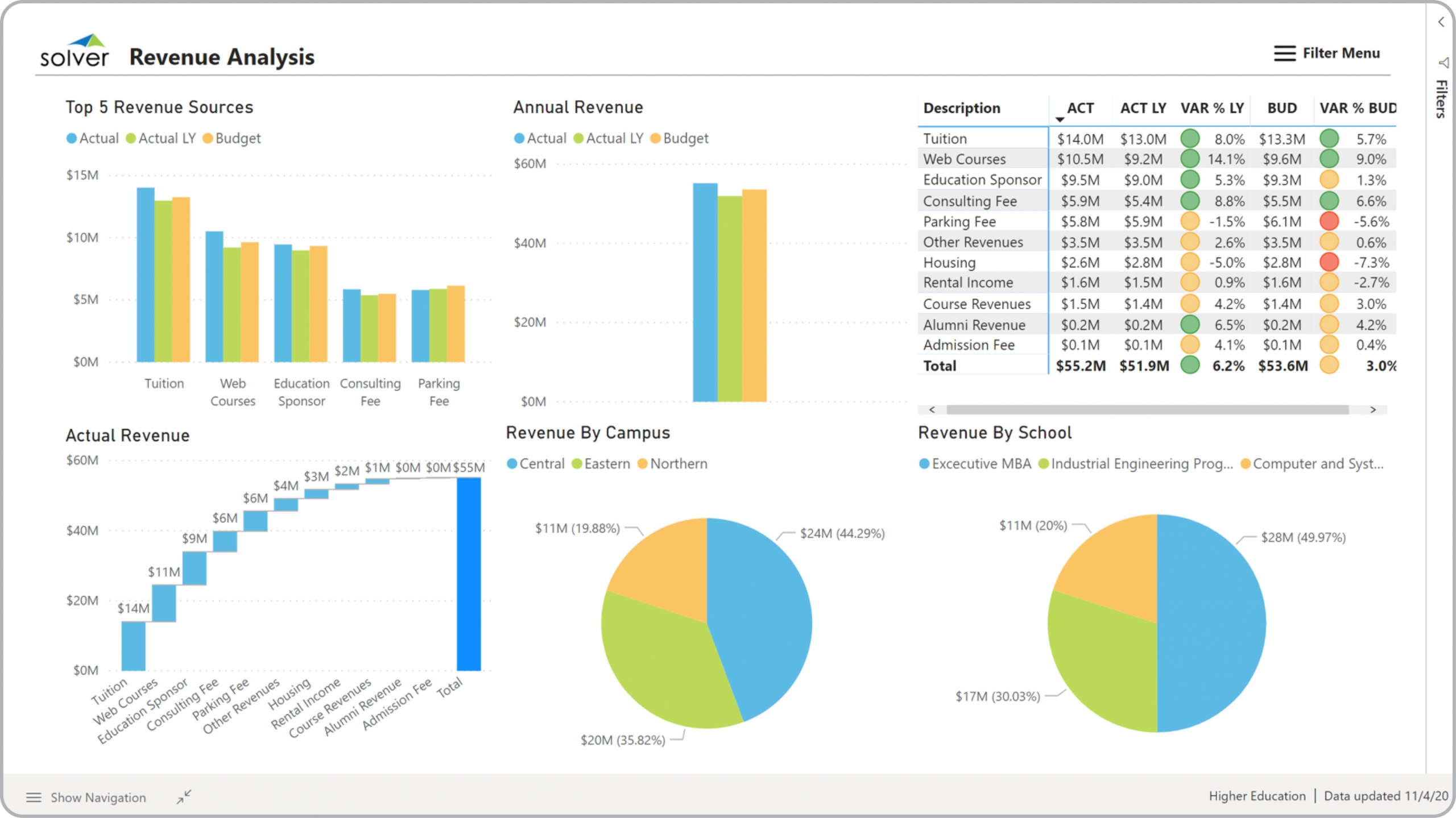Revenue Dashboard for Higher Education Institutions
What is a
Revenue Dashboard for Higher Education Institutions
? Revenue Dashboard are considered funding analysis tools and are used by executives and CFOs to quickly understand revenue sources and variances. Some of the main functionality in this type of dashboard is that it gives the user a simple way to analyze funding sources from six different perspectives: 1) Top five revenue sources with comparison of actual, actual last year and budget. Sources listed in the example include: Tuition, Web courses, Education sponsor, Consulting fees, Parking fees, 2) Total annual revenue with actual and budget comparison, 3) Table with ranked listing of all revenue sources and comparison of actual figures with actual last year, variance (%), budget and budget variance, 4) Build up of components of actual revenue, 5) Revenue by campus, and 6) Revenue by school. The user can apply filters using the "Filter Menu" on top of the screen. You find an example of this type of dashboard below.
Purpose of
Higher Ed Revenue Dashboards Universities and colleges use Higher Ed Revenue Dashboards to provide executives with different ways to slice and compare revenue streams. When used as part of good business practices in Financial Planning & Analysis (FP&A) departments, an organization can improve its decision speed and revenues, and it can reduce the chances that leaders miss important performance issues.
Example of a
Higher Ed Revenue Dashboard Here is an example of a Revenue Dashboard with comparison of different sources of funds as well as budget variances. [caption id="" align="alignnone" width="2560"]
 Example of a Revenue Dashboard for Higher Education Institutions[/caption] You can find hundreds of additional examples
here
Who Uses This Type of
Dashboard
? The typical users of this type of dashboard are: Boards, Executives and Office of Finance.
Other Reports Often Used in Conjunction with
Higher Ed Revenue Dashboards Progressive Financial Planning & Analysis (FP&A) departments sometimes use several different Higher Ed Revenue Dashboards, along with Financial statements, detailed funding reports, annual budgets, KPI dashboards and other management and control tools.
Where Does the Data for Analysis Originate From? The Actual (historical transactions) data typically comes from enterprise resource planning (ERP) systems like: Microsoft Dynamics 365 (D365) Finance, Microsoft Dynamics 365 Business Central (D365 BC), Microsoft Dynamics AX, Microsoft Dynamics NAV, Microsoft Dynamics GP, Microsoft Dynamics SL, Sage Intacct, Sage 100, Sage 300, Sage 500, Sage X3, SAP Business One, SAP ByDesign, Acumatica, Netsuite and others. In analyses where budgets or forecasts are used, the planning data most often originates from in-house Excel spreadsheet models or from professional corporate performance management (CPM/EPM) solutions.
What Tools are Typically used for Reporting, Planning and Dashboards? Examples of business software used with the data and ERPs mentioned above are:
Example of a Revenue Dashboard for Higher Education Institutions[/caption] You can find hundreds of additional examples
here
Who Uses This Type of
Dashboard
? The typical users of this type of dashboard are: Boards, Executives and Office of Finance.
Other Reports Often Used in Conjunction with
Higher Ed Revenue Dashboards Progressive Financial Planning & Analysis (FP&A) departments sometimes use several different Higher Ed Revenue Dashboards, along with Financial statements, detailed funding reports, annual budgets, KPI dashboards and other management and control tools.
Where Does the Data for Analysis Originate From? The Actual (historical transactions) data typically comes from enterprise resource planning (ERP) systems like: Microsoft Dynamics 365 (D365) Finance, Microsoft Dynamics 365 Business Central (D365 BC), Microsoft Dynamics AX, Microsoft Dynamics NAV, Microsoft Dynamics GP, Microsoft Dynamics SL, Sage Intacct, Sage 100, Sage 300, Sage 500, Sage X3, SAP Business One, SAP ByDesign, Acumatica, Netsuite and others. In analyses where budgets or forecasts are used, the planning data most often originates from in-house Excel spreadsheet models or from professional corporate performance management (CPM/EPM) solutions.
What Tools are Typically used for Reporting, Planning and Dashboards? Examples of business software used with the data and ERPs mentioned above are:
- Native ERP report writers and query tools
- Spreadsheets (for example Microsoft Excel)
- Corporate Performance Management (CPM) tools (for example Solver)
- Dashboards (for example Microsoft Power BI and Tableau)
Corporate Performance Management (CPM) Cloud Solutions and More Examples
May 7, 2021
TAGS:
Reporting,
Solver,
report writer,
Microsoft,
template,
campus,
practice,
Acumatica,
Netsuite,
college,
Finance,
planning,
GP,
dashboard,
Business Central,
higher ed,
excel,
ax,
higher education,
forecast,
Budget,
Dynamics 365,
budgeting,
university,
revenue,
school,
Cloud,
Software,
Tableau,
SAP,
example,
best,
Sage,
BC,
D365,
NAV,
Intacct,
revenue dashboard,
CPM,
report,
SL,
Management,
dynamics,
Power BI,
revenue analysis,
sources of funds

